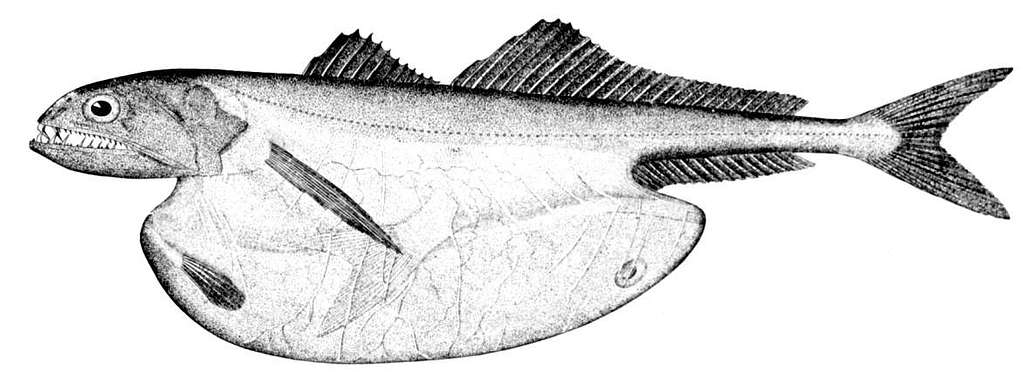
The Black Swallower fish (Chiasmodon niger) is a fascinating creature found in the deep waters of the ocean. Known for its distinctive appearance and extraordinary feeding habits, this species captivates marine biologists and enthusiasts alike. In this article, we explore 19 intriguing facts about the Black Swallower fish, shedding light on its remarkable characteristics and enigmatic lifestyle.
Exceptional Adaptability
Black Swallowers are uniquely adapted to withstand the extreme conditions of the deep sea. Their bodies are built to withstand high pressures and low temperatures, enabling them to thrive in the abyssal depths.
Elusive Depths
These deep-sea dwellers are typically found in depths ranging from 2,000 to 10,000 feet, where they roam the dark waters in search of prey.
Eerie Appearance
With a long, slender body and dark coloration, the Black Swallower fish possesses an eerie and striking appearance. This physical adaptation allows it to blend seamlessly into the depths, camouflaging itself from potential predators and prey.
Unusual Size
Despite their elongated bodies, Black Swallowers are relatively small fish, measuring around 9 to 10 inches in length on average. However, their ability to consume prey larger than themselves is truly astonishing.
Voracious Appetite
Black Swallowers are renowned for their extraordinary feeding habits. These opportunistic hunters possess an expandable stomach that allows them to swallow prey much larger than their own size, stretching their bodies to accommodate the meal.
Ambush Predators
Employing a sit-and-wait strategy, Black Swallowers remain motionless in the depths, lurking for unsuspecting prey to pass by. Once a suitable meal is within reach, they swiftly engulf it in their cavernous jaws.
Digestion Challenges
The Black Swallower faces a unique challenge after consuming a large meal. The digestion process is slow due to the low metabolic rate in deep-sea environments. As a result, the fish must adapt to long periods of fasting between meals.
Exceptional Stretchability
Thanks to their remarkably stretchable stomachs, Black Swallowers can consume prey up to twice their own size. Their elastic stomachs accommodate the meal and gradually contract as digestion takes place.
Preferred Diet
Black Swallowers primarily feed on deep-sea creatures such as lanternfish, eels, and squid. Their ability to consume prey larger than themselves allows them to capitalize on a wider range of potential food sources.

Slow Metabolism
Black Swallowers have a slow metabolic rate, allowing them to survive with limited food intake. This adaptation enables them to endure long periods of scarcity in the deep-sea environment.
Luminous Lure
To attract prey, the Black Swallower possesses bioluminescent organs that produce a faint glow. This lure serves to entice curious organisms closer, making them vulnerable to the fish’s swift strike.
Deep-Sea Adaptations
Living in pitch-black depths necessitates unique adaptations. The Black Swallower has highly sensitive eyes, allowing it to detect subtle movements and spot potential prey in the dark abyss.
Expanding Bladder
As a Black Swallower consumes prey larger than itself, its bladder expands to accommodate the swallowed meal. This remarkable adaptation ensures the fish remains buoyant despite the increased weight.
Mysterious Migrations
Little is known about the migration patterns of Black Swallowers. Some evidence suggests they may undertake vertical migrations, ascending to shallower depths during certain times of the year.
Rare Sightings
Due to their elusive nature and deep-sea habitat, sightings of Black Swallowers are relatively rare. Encounters with this captivating fish provide invaluable insights into its behavior and biology.
Species Discovery
The Black Swallower fish was first described by Carl Linnaeus, the father of modern taxonomy, in 1758. Since then, ongoing research efforts have gradually unveiled the mysteries surrounding this enigmatic creature.
Deep-Sea Exploration
Studying the Black Swallower fish and other deep-sea organisms helps researchers expand their understanding of the unique ecosystems hidden in the depths. It also sheds light on the adaptations necessary for survival in extreme environments.
Threats to Survival
While data on population trends is limited, human activities such as deep-sea trawling and climate change pose potential threats to the Black Swallower’s habitat. Protecting and conserving deep-sea ecosystems is crucial to the preservation of these remarkable species.
Ongoing Research
Researchers continue to explore the depths of the ocean, pushing the boundaries of knowledge regarding the Black Swallower fish and its mysterious way of life. Their findings contribute to the growing body of scientific knowledge surrounding deep-sea organisms.
Conclusion
In conclusion, the Black Swallower fish stands out as a remarkable and mysterious creature of the deep. Its ability to consume prey larger than its own size, adapt to extreme conditions, and exhibit unique characteristics makes it an intriguing subject of study. By delving into the secrets of the Black Swallower fish, researchers unlock a deeper understanding of the fascinating world hidden beneath the ocean’s surface.
Frequently Asked Questions (FAQs)
How deep does the Black Swallower fish live?
Black Swallowers inhabit depths ranging from 2,000 to 10,000 feet in the ocean.
Can the Black Swallower fish eat prey larger than itself?
Yes, Black Swallowers have an expandable stomach that enables them to swallow prey larger than their own size.
What do Black Swallowers eat?
Their diet consists of deep-sea creatures such as lanternfish, eels, and squid.
How big is the Black Swallower fish?
On average, the Black Swallower measures around 9 to 10 inches in length.
What makes the Black Swallower fish unique?
The Black Swallower possesses an elastic stomach, slow metabolism, and bioluminescent organs, making it well-adapted to the deep-sea environment.
Was this page helpful?
Our commitment to delivering trustworthy and engaging content is at the heart of what we do. Each fact on our site is contributed by real users like you, bringing a wealth of diverse insights and information. To ensure the highest standards of accuracy and reliability, our dedicated editors meticulously review each submission. This process guarantees that the facts we share are not only fascinating but also credible. Trust in our commitment to quality and authenticity as you explore and learn with us.


